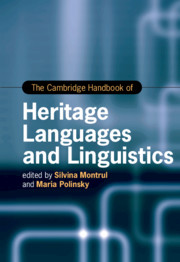Book contents
- The Cambridge Handbook of Heritage Languages and Linguistics
- Cambridge Handbooks In Language And Linguistics
- The Cambridge Handbook of Heritage Languages and Linguistics
- Copyright page
- Dedication
- Contents
- Figures and Tables
- Contributors
- Acknowledgments
- Introduction
- Part I Heritage Languages around the World
- Part II Research Approaches to Heritage Languages
- 15 Heritage Language Research and Theoretical Linguistics
- 16 The Emergence of Heritage Language
- 17 Sociolinguistic Approaches to Heritage Languages
- 18 The Psycholinguistics of Heritage Languages
- 19 Contact Linguistics and Heritage Languages
- 20 A Narrative-Ethnographic Approach to Research on Heritage Language Development
- 21 Corpus-Based Methodologies in the Study of Heritage Languages
- 22 Current Trends and Emerging Methodologies in Charting Heritage Language Grammars
- Part III Grammatical Aspects of Heritage Languages
- Part IV Heritage Language Education
- Index
- References
20 - A Narrative-Ethnographic Approach to Research on Heritage Language Development
from Part II - Research Approaches to Heritage Languages
Published online by Cambridge University Press: 04 November 2021
- The Cambridge Handbook of Heritage Languages and Linguistics
- Cambridge Handbooks In Language And Linguistics
- The Cambridge Handbook of Heritage Languages and Linguistics
- Copyright page
- Dedication
- Contents
- Figures and Tables
- Contributors
- Acknowledgments
- Introduction
- Part I Heritage Languages around the World
- Part II Research Approaches to Heritage Languages
- 15 Heritage Language Research and Theoretical Linguistics
- 16 The Emergence of Heritage Language
- 17 Sociolinguistic Approaches to Heritage Languages
- 18 The Psycholinguistics of Heritage Languages
- 19 Contact Linguistics and Heritage Languages
- 20 A Narrative-Ethnographic Approach to Research on Heritage Language Development
- 21 Corpus-Based Methodologies in the Study of Heritage Languages
- 22 Current Trends and Emerging Methodologies in Charting Heritage Language Grammars
- Part III Grammatical Aspects of Heritage Languages
- Part IV Heritage Language Education
- Index
- References
Summary
This chapter presents a qualitative approach to research on heritage language development – narrative ethnography, which integrates text-based methods of narrative analysis with field-based, interaction-enriched methods of linguistic anthropology. It begins with an overview of its epistemological orientations and an exploration of its usefulness for heritage language research before discussing its methodological orientations. It is argued that such an approach is particularly productive for a context-dependent field such as heritage language development. The chapter concludes with a consideration of the merits and challenges of this approach and its potential to advance knowledge about heritage language development and learning.
- Type
- Chapter
- Information
- The Cambridge Handbook of Heritage Languages and Linguistics , pp. 499 - 519Publisher: Cambridge University PressPrint publication year: 2021



